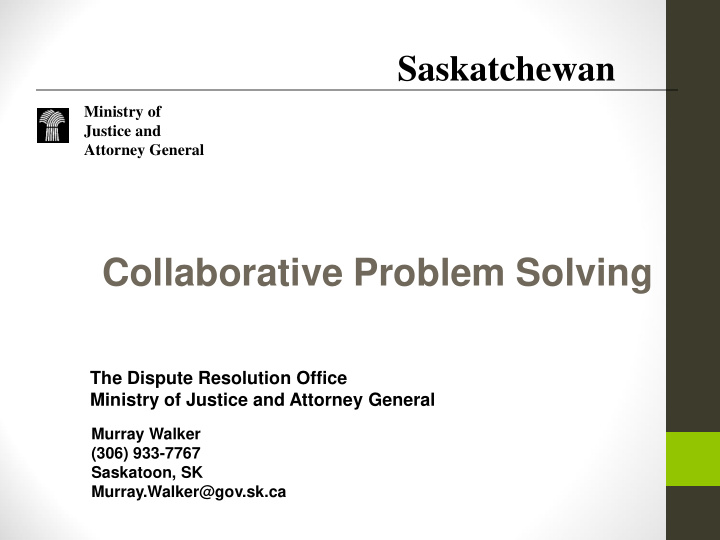



Saskatchewan Ministry of Justice and Attorney General Collaborative Problem Solving The Dispute Resolution Office Ministry of Justice and Attorney General Murray Walker (306) 933-7767 Saskatoon, SK Murray.Walker@gov.sk.ca
The Dispute Resolution Office … “We believe in people’s ability to resolve issues with dignity and respect in a safe environment”. Mission Statement Our mission is to enhance the understanding and accessibility of collaborative problem solving and decision-making. Goals The Dispute Resolution Office will enhance the understanding and accessibility of collaborative problem solving and decision-making by: Providing professional mediation and facilitation services; Being actively involved in the development and promotion of collaborative dispute resolution within the Province; Providing technical expertise and assistance to public sector organizations; Providing training in communication, conflict resolution and mediation to public sector organizations; Supporting the development of restorative justice initiatives.
Satisfaction Triangle
Substantive Interests • Quality of … (eg. Resources, Education, Health Care) • Quantity of …(eg. Resources, Education, Health Care) • Efficient/Effective Procedural Interests • Participation / Input • Be heard • Ownership of Outcome • Informed Choices • Legitimacy Psychological Interests • Dignity/Respect • Valued/Recognition • Identity (internal: how I see myself) • Reputation (external: how others see me)
Process Steps • 1.Identify Topic or Issue • 2.Identify Interests or Needs • 3.Problem Solve/ Options to Resolve • 4.Implementation Plan
Private Public Intent (Motives ) ACTIONS, Messages WORDS, EVENTS Effect (Impact) Filter based on Beliefs, values, relationships, Frame of Mind There are “messages” received from words/actions that may not be intended based on our “filter”. The message may be about Psychological/Identity needs.
Process Choices The process choices or approaches to make decisions fall into the following 3 categories. (1) Decide without Consultation (2) Consult with others, but ultimately retain authority to make the decision (3) Consensus – everyone agrees with the outcome.
Collaborative Continuum Arbitrate/ Consult Collaborate Consensus Inform Factors (1)Time (2)Importance of Issue (3)Size and Complexity of Issue (4)Level of Knowledge of Participants (5)Impact of Issue (6)Need for Ongoing Relationship
Conflict Escalation MUTUAL SELF-DESTRUCTION HURT BEFORE BEING HURT PERSONALIZE AND STEREOTYPE BECOME MORALISTIC BELIEFS FEED OBSERVATIONS GROUP THINK RELY ON ASSUMPTIONS ATTRIBUTE MOTIVES LOOK FOR SUPPORT GET DEFENSIVE ASSUME DELIBERATE ACTIONS COMPETITION CO-OPERATION
Reciprocity - Social obligation to give back to you the form of behaviour you first give to me. Repay in kind - Also true in the negative - Respect - Power
Interest Based Questions Understand “why” without asking why “What’s important to you” “What would that accomplish” “What is the impact”
Validation • What can you agree with? • Interests • Impact
So Soun unding ding Boa oard Validation & Challenge ♦ Acknowledge the Impact ♦ Opportunity to look at alternative points of view ♦ Challenge to take positive first steps to resolve
Raising Issues 1. State the situation from your perspective. What has been your experience. 2. What has been the significance or impact of this situation to you personally (use “I” language / centered speaking). 3. Get a commitment to work to create a change that is acceptable for both of you.
Recommend
More recommend